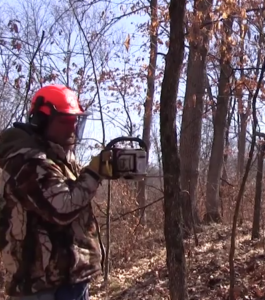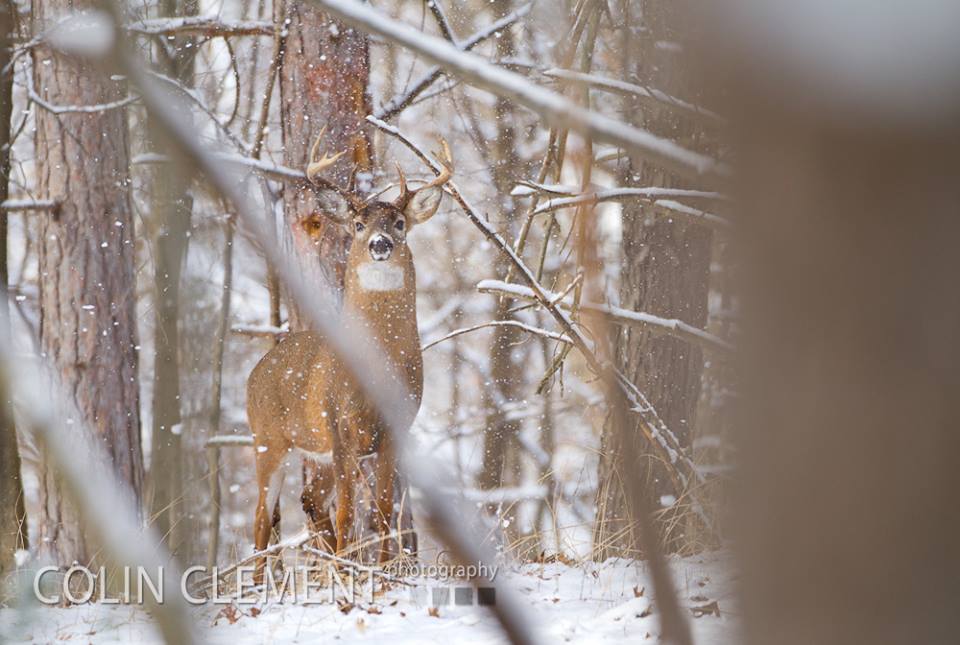Hing-cutting trees is an ideal way to create wildlife habitat, especially bedding cover for whitetail deer. If you hunt in an area with a high deer population, you may find a distinct or marginal browse line where whitetail deer have eaten small shrubs and emerging trees during the winter. I hunt such a property and can shoot 200 yards through standing trees because deer have consumed all the underlying vegetation.
How it Works
 Hing-cutting is the process of cutting the trunk of a small tree, but not completely severing it from the stump. Typically, the cut is about three feet above the ground and the top of the tree is allowed to bend over and create cover for nesting birds and bedding deer. Additionally, deer browse the tips of the tree depending on its species.
Hing-cutting is the process of cutting the trunk of a small tree, but not completely severing it from the stump. Typically, the cut is about three feet above the ground and the top of the tree is allowed to bend over and create cover for nesting birds and bedding deer. Additionally, deer browse the tips of the tree depending on its species.
Hing-cutting keeps the tree alive, often for several years such that the branches sprout leaves creating excellent ground cover. Deer rarely bed in my hunting area because the under-story is so open and by using this management technique, I can transform a transition area into a place where deer will bed and turkeys will nest.
Safety Concerns
Many wildlife managers who employ hing-cutting do so with a chainsaw which can be problematic if not done correctly. Cutting trees is not for amateurs and using this special cut requires greater skill and different techniques than felling timber. Some managers will only cut trees that they can down with a handsaw which helps keep the process safe. Others use ropes, lines, or other measures to pull a tree down and do it safely.
This post from QDMA examines this process in depth. If you want to create bedding on your property, now is the time, and this post will help you create the successful habitat you seek. Be careful out there and good hunting.
Hinge-cutting has exploded in popularity in recent years, and as with anything that explodes in popularity, some people take it too far, focusing too much on the technique while missing the bigger picture. It has happened before in deer management, and this time it has even become a point of tension in the wildlife management community.
On one side, some foresters and biologists believe expectations for what hinge-cutting can produce have gotten out of hand. On the other, many experienced habitat consultants and their satisfied customers swear by the practice and bristle at any suggestion that hinge-cutting is not a fantastic technique. The solution, in my view, is to consider the valid points that both sides bring to the discussion.



















![The Best Deer Camp Chili [VIDEO] Deer Chili Ingredients, Tomatoes, Chili Spices](/wp-content/uploads/2015/10/Deer-Chili-Deer-Camp-Recipe-218x150.jpg)
![How to Call Elk Early in the Season [VIDEO]](/wp-content/uploads/2016/08/byers003-218x150.jpg)




![Idiots Disturb Hunter: How Would You Have Handled It? [VIDEO]](/wp-content/uploads/2015/10/DSC00110-e1474487693878-100x70.jpg)
![Albino Buck Shocked to Shed His Antlers [VIDEO]](/wp-content/uploads/2015/10/AlbinoDeer-100x70.jpg)